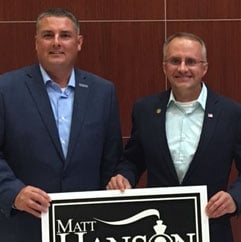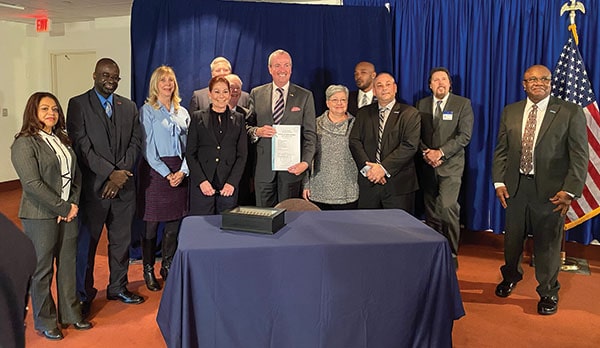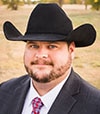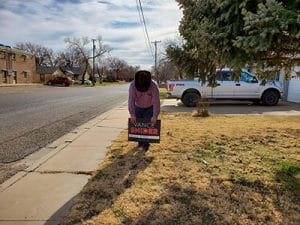Matt Hanson, alternate legislative representative and trustee for Local 171 (Aurora, Ill.), is continuing his bid to retain his seat on the Kane County Board.
Hanson, an incumbent seeking a full term, is facing a Democratic primary challenge March 18 and continues to build momentum for a successful campaign with endorsements from the North Central Illinois Labor Council (NCILC) and the Fox Valley Building Trades (FVBT) along with several elected officials since entering the 2020 election cycle.
“I will continue to govern, drive discussion, and vote to support all employees of Kane County whether or not protected through collective bargaining,” Hanson said in an email. “Votes can be cultivated and secured using a variety of means, all of which I look to utilize. I always “do the work” for myself and like-minded candidates when my assistance is requested.”
During this effort, Hanson’s been juggling time serving on the county board, his union officer responsibilities, and his full-time career as a locomotive engineer for BNSF and can use the support of his fellow union brothers and sisters both in Illinois and elsewhere.
He has a fund-raising event scheduled 5 to 7 p.m. Feb. 3 at Mike & Denise’s Pizzeria, 1760 N. Farnsworth Ave., Aurora, Ill., 60505, and invites members to come out and support his efforts. Tickets are $25.
“Any help that can be lent is needed and immensely appreciated,” said Hanson. “I am proud to tell everyone encountered on the campaign trail that I am a card-carrying union railroader that belongs to SMART-TD Local 171.”
To contact Hanson and contribute to his campaign, email matt4kane@gmail.com or mail checks to Friends of Matt Hanson, P.O. Box 1101, Aurora, IL 60507.
Author: bnagy
A two-person crew bill is headed to the Virginia House of Delegates’ Commerce and Labor Committee and SMART-TD members in the region are asked to come show their support for the legislation.
H.B. 440 is scheduled for a first hearing in the House Committee Room in the afternoon of Thursday, Jan. 16, in the state Capitol Building, 1000 Bank St., in Richmond, Va. The time that the bill will be discussed is undetermined as the committee meeting begins a half-hour after the adjournment of the House of Delegates’ regular session that day.
The bill has been introduced by Delegate Steve E. Heretick of District 79 and establishes fines for freight carriers who do not operate with two crew members in the cab with exceptions for hostler or yard service.
“We’d never gotten it out of the subcommittee before,” Virginia State Legislative Director Ronnie Hobbs said. “Now it has gone straight to committee.”
A great show of support from union members in the state will help to show the legislators that this legislation matters for the safety of both rail workers and for the public.
“I’d love to fill the room with railroad folks,” Hobbs said.
For more details on how to meet and show support, contact Hobbs at rhobbs1313@gmail.com.
It’s time to get the TAR in orderThe SMART Constitution requires the Treasurer’s Annual Report (TAR) to be presented to the membership and then filed at the start of the calendar year. Local trustees are to assemble this month to perform an annual audit of a Local’s finances and review the receipts and disbursements for the prior year before signing the report. The report is then presented at the Local’s next meeting and copies are filed and submitted to the SMART-TD offices before a Feb. 20 deadline. The 2019 TAR has substantial differences from past years. Historically, the TAR simply generated a high-level financial overview of a local’s books, but over the last several years the Field Support Team has seen an increase in locals that get behind on other required business-related duties. This revised TAR will flag items that are not getting completed to help a Local catch up on its bookkeeping. Local Treasurers can work along with Trustees to review these items and formulate a plan for fixing them as part of the report to the SMART-TD office. Additionally, this will allow Field Support to identify Locals needing additional assistance earlier so that catching up and getting into compliance is not a monumental undertaking. The revised TAR will be more detailed and include other action items that should be reviewed and signed off on by Local Trustees and show a better, more detailed position of the Local’s fiscal outlook along with its compliance with SMART constitutional and federal requirements. With the changes, S&Ts and local officers should note that the revised TAR will only be available via the WinStabs-NMR software. There is no longer a paper form. If you have not yet started using WinStabs-NMR, contact the Field Audit Support Team IMMEDIATELY. New information has been posted on the S&T Tools page of the SMART-TD website to help you along in this process under the “Required Reports” header. These guides to completing the TAR include:
Other steps will help you to make composing the report easier. These include:
While the changes in this year’s TAR require adjustments on the part of Local officers, these differences will help your Local to emerge from the process with a clearer view of where the Local stands from a money perspective. Your guide to the year aheadThe essential guide to keeping track of your local’s finances is now available on the TD website. The 2020 treasurer’s month-to-month guide serves as a checklist that goes step by step through the year showing what deadlines need to be met in order to make your job easier and to keep Local finances running smoothly. |  Important dates • Jan. 20 — Registration deadline for Kansas City, Mo., workshops. • Jan. 27-29 — S&T workshop in Kansas City, Mo. • Jan. 30 — Local president/trustee workshop in Kansas City, Mo. Before Jan. 31 — • By Feb. 20 — Treasurer’s annual report (TAR) for 2019 and Local President Financial Oversight forms due to TD. Completed reports can be submitted directly from WinStabs-NMR or send a copy of the signed and dated form to the TD office. Email: Mail: Questions? Visit the S&T Tools page on the SMART TD website for guidance on getting the job done! Still not sure? Call the Field Support Help Desk at 216-227-5444. Drop-in help desk hours are 9a-5p (Central Time) M-W-F. Help desk appointments can be scheduled in advance for Tuesdays, Thursdays, weekends, and evenings. Call or email fieldauditor@ |
Training opportunities for Local officers
Workshop offerings are being finalized for S&Ts who are interested in learning the ins-and-outs of running the finances of your Local.
Among the topics to be discussed are:
- Using TD Connect
- WinStabs
- Creating required reports
- Financial pitfalls to avoid
The first workshop for S&Ts in Kansas City, Mo., scheduled for Jan. 27 to 30 has been filled. A second workshop on Jan. 30 for Local Presidents and Trustees to better understand their fiscal role in the Local has limited space remaining ahead of the Jan. 20 registration deadline.
Additional workshops in 2020 are in the process of being finalized in Philadelphia, Salt Lake City and New Orleans as well as one planned during the Cleveland Regional Meeting in August.
Details and registration information for all workshops will be posted to the Training & Events section of the S&T Tools page on the SMART TD website as well as emailed out through the Making Cents enewsletter. Don’t miss out on these chances to expand or refresh your knowledge of the duties of your office!
New Jersey Gov. Phil Murphy signed S. 3425 into law on Jan. 9, a bill requiring rail carriers to maintain vegetation near and around crossings in the state.
The bill passed through the New Jersey Senate last May by a unanimous 35-0 vote and later in December was approved unanimously by the state’s Assembly.
It requires vegetation to be cleared by at least 300 feet from crossings by rail carriers. If the carriers do not comply within 15 days of receiving written notice that a crossing must be cleared, then the state Department of Transportation will clear the vegetation and charge the carriers for the cost of doing so.
“Excessive vegetation has the potential to cause harm to commuters, railroad workers, and many others,” said SMART-TD New Jersey State Legislative Director Ronald Sabol. “Thank you to the governor for signing this important legislation that will improve safety across our statewide rail system.”
Sen. Patrick J. Diegnan, Jr. of New Jersey’s 18th District was the bill’s primary sponsor.
His hands are rough. His boots are dirty. He has the resume to prove it.
Vance Snider is a SMART Transportation Division member out of Local 1313 in Amarillo, Texas, a veteran of the U.S. Army, a father of two and a BNSF conductor.
He’s also running for Congress to represent Texas’ 13th District, an open seat with the announced retirement of Rep. Mac Thornberry at the conclusion of the 116th Congress.
“My hands are rough, my boots are dirty, and I’m not a career politician” is the quote that introduces his biography on his campaign website.
He has the background to prove that — working his way up from sweeping floors in his dad’s parts shop in Texas and fighting for our country on foreign soil.
Vance Snider, a member of Local 1313 in Amarillo, Texas, is running in the Republican primary for the U.S. House of Representatives in Texas’ 13th District.
Snider, 30, served in Afghanistan after enlisting in the Army in December 2007 after his high school graduation. After completing his service, he hired on to the Texas Northwestern Railway in 2013 and later moved on to become a conductor for BNSF.
He’s been a TD member since April 2015 and is running as a first-time candidate as a Republican to represent the 13th District, which is home to hundreds of SMART-TD members and retirees and their families. He will need their support to win in the crowded 15-candidate primary that takes place March 3, and he plans to fight for our members and the people in the district if elected.
It’s a challenge to be sure. The 13th is a vast district that has more ground to cover than 13 U.S. states and one of the most Republican. The winner of the Republican primary is practically a shoo-in to win in November and move on to D.C. — Thornberry won his last re-election bid with 81 percent of the vote.
And Snider is doing his best to break the typical red-blue stereotype. He’s a registered Republican because his values align most with the pro-life and pro-Second Amendment stance of the party. But when out talking to prospective voters, he said that sometimes people who identify as Republican get hung up on the fact that he’s a proud union member.
“Republicans are typically associated with big business,” Snider said. “They forget about the little people who made them the millions of dollars.”
So he’s trying to change that by infusing some youth into the party and to break some of the typical set-in-stone party preconceptions by running for the House.
The 2018 election and the hyperpartisanship in D.C. is what inspired him to run – he’s tired of seeing people staying in Congress for decades but then ignoring important issues such as railroad safety.
“I want to go forth and create a revolution – bring regular people to the House and Senate. Get rid of the incumbents,” Snider said. “It’s about taking action and doing something about it.
“I got tired of the political BS going between the two parties. That’s what really annoyed me.”
Since officially becoming a candidate on the ballot in early October and even before then, Snider has been campaigning on his own terms. He’s found that some of the 14 other Republicans competing for the chance to appear on the November 2020 ballot have been following his lead.
“I’m actually out there hitting the pavement – I was one of the first ones to put the name on the ballot and put out yard signs,” he said. “They’re all copying my campaign. I’ve been hand-delivering yard signs – the campaign seems to be going really well. I ain’t scared to get up at 6 in the morning and drive across the country, so putting a few miles on my truck doesn’t bother me.”
“Politicians need to start working for the people,” he said. “They need to elect a like-minded individual who thinks about the people in the district first, then the rest of the country. I want to start a revolution – show I’m a normal Joe Blow guy like you — and can get out and do something.”
After Thornberry, who’s held the seat in the 13th District for 25 years, announced his retirement, Snider fully committed the run and he’s had 100% support from his wife, Christy, and the rest of his family.
His platform includes a commitment to being pro-life and defending Second Amendment rights. He also counts rail safety as an issue in his campaign, which sets him apart from others in his party and has led to the backing of his campaign by SMART TD PAC and others associated with rail labor.
The number of co-sponsors show that current incumbent Republicans have been slow to come around in supporting the two-person freight crew legislation (H.R. 1748 in the House and S. 1979 in the Senate). Thornberry has not signed on to the Safe Freight Act, and so far only 10 GOP reps have signed on as co-sponsors compared with 124 Democrats.
But Snider sees hope that rail safety and having two on the crew will eventually be recognized as a non-partisan issue that goes beyond red or blue.
“We need to get Republicans aboard,” he said. “I’ve had national support from all over the country – I’ve got donations from Democrats and Republicans. It’s about being working class, a working person – making sure we’re all taken care of.”
“We need to give the honest truth – make the public aware of it. A lot of them think we still have five people on the train,” he said.
The public also does not recognize that there are safety and environmental factors to railroad accidents that would be worsened by going from two to one person in the cab, he said, pointing out that a Jan. 1 derailment into the Kootenai River in Idaho could have easily resulted in a fatality had there not been two people aboard to assist one another to survive in their BNSF locomotive that was partially submerged during the accident.
“It’s about informing the public. It’s about safety. And public awareness — that’s what it comes down to,” he said.
Moreover, the work schedule of a railroader does not help matters when it comes to rail safety, and having two aboard is an important check, even with Positive Train Control.
“Whenever you’re working an extra board, you’re fatigued,” he said. “There’s been issues where a signal drops from clear to red—there’s more going on out there than people think. When you have those instances when you have to have someone out there, two sets of eyes are better than one.
“There have been times when guys have missed a signal, and you have to speak up.”
There are a number of ways rail workers and union members can speak up – one of them is by running for public office, as Snider is.
“It took me two weeks to get through the red tape. If I can do it, you can do it too,” he said. “Once you get through the red tape, find a good campaign consultant and an election lawyer who can tell you what can and can’t be done – those are the two key things. Then put your nose to the grindstone and start campaigning.”
A second way that isn’t as time intensive, but helps just the same is by donating to the TD PAC.
“I would encourage people to donate to PAC. You really can help by donating to the PAC fund, no matter what the level,” he said. “It really helps out and allows candidates like me to go forward. It is bipartisan and goes to both Republicans and Democrats. This money doesn’t come from union dues.”
Snider is looking to change things for people in his congressional district, his fellow union members and in Washington, D.C. To find out more about him and how you can help our union brother in his campaign, visit www.vancesniderforcongress.com search Vance Snider for U.S. Congress on Facebook or email vancesniderforcongress@gmail.com.
For more information about how to contribute to SMART TD PAC, email TDPAC@smart-union.org or visit https://www.smart-union.org/td/washington/tdpac/
Just before the start of the new year, deals that resulted in the Genesee & Wyoming (G&W) and the Central Maine & Quebec (CM&Q) changing hands were finalized.
The Surface Transportation Board in November cleared the way for Brookfield Asset Management and GIC, a Singapore wealth fund, to acquire Genesee & Wyoming, which controls Class II and III railroads in 41 states and, if considered collectively, has holdings that qualify it as a Class I carrier with more than 13,000 track miles.
A review by the Committee on Foreign Investment in the United States (CFIUS) permitted the acquisition to be finalized, and completion of the deal was announced Dec. 31. G&W is now a private entity and its stock is no longer traded publicly.
In the case of Canadian Pacific’s acquisition of CM&Q, the federal Surface Transportation Board still must sign off on the deal, which was announced Nov. 20, to make it official. Financial terms were finalized on Dec. 30, CP announced.
Once approved by the STB, CP’s purchase from Fortress Transportation and Infrastructure Investors LLC would give the Class I carrier trackage and facilities from St. Jean, Quebec, Canada, to Searsport, Maine.
SMART Transportation Division represents 52 members on the CM&Q in the Transportation, Mechanical and Engineering Departments who belong to GO-049, which is represented by General Chairman Rick Lee. CM&Q owns 481 miles of rail lines primarily in Quebec and Maine.
The family of Brother Curtis C. McConihay has established a memorial fund for his two daughters.
He was a U.S. Marine veteran and lived in Southside, W.Va., with his wife, Megan, and their two daughters, Madalynn and Alexis. He joined SMART-TD in May 2015 and was a conductor for CSX.
Contributions to the family can be made through PayPal at https://www.paypal.com/paypalme2/mcconihay.
“Please let us keep his family in our thoughts and prayers, as his family is now our family,” said Local 1386 Chairperson W.R. Parsons. “We will keep his memory alive by remembering the good times as we are better people for knowing him. God bless his wife Megan and his precious daughters.”
His obituary can be read here.
A message from Palmetto GBA:
Whether you’re new to Railroad Medicare or starting a new year with Railroad Medicare, it’s important to know about the change to how Medicare identifies you.
In 2020, Medicare providers must use your new Medicare number. The old Social Security-based number can no longer be used for claims filing, no matter what date your provider furnished a service to you. This means if you had a doctor’s visit on January 15, 2019, the provider must file the claim before January 15, 2020 and they must use your new Medicare number. If your provider does not have your new number, you need to give that to them. Claims filed without the new number will be rejected by Medicare and cannot be processed for any payment.
If the provider is not able to get with you to get your new number, they can use our Medicare number lookup tool on our website. We would hope this would be the exception, not the norm. In order to use the Medicare lookup tool, the provider must have your Social Security number (SSN). If you do not want to give your SSN to a provider, make sure to show them your Medicare card with your new Medicare number.
Additionally, you will also need to use your new Medicare number if you call customer service at Railroad Medicare or 1-800-MEDICARE. Medicare contractors cannot accept any other form of identification over the telephone or in writing.
Here are the details about new Medicare number:
- It will have 11 characters.
- The numbers will be generated randomly. Medicare considers them ‘non-intelligent’ numbers that don’t have any hidden or special meaning.
- It will be unique to each patient.
- It will contain capital letters (all letters with the exception of S, L, O, I, B and Z) and numbers (0-9).
- The 2nd, 5th, 8th, and 9th characters will always be a letter, while characters 1, 4, 7, 10, and 11 will always be a number. The 3rd and 6th characters will be a letter or a number.
- There will be no dashes in the numbers on the card.
As you may have experienced in the past, providers can’t always tell the difference between a Social Security Medicare patient and a RRB patient. They may submit your claims to regular Medicare instead of Railroad Medicare. To help providers know what patient they have, the new cards will have the RRB logo on them when applicable, so your doctor’s office will know where to submit claims. Your provider can also use an online portal if they have your Medicare number but don’t know if it’s a Railroad Medicare number. We educate providers on our portal regularly, but some may not be aware.
If you have a provider who may be confused, have them call our Provider Contact Center at 888-355-9165. Customer service representatives are available 8:30 a.m. to 4:30 p.m. Monday through Friday in all time zones with the exception of the Pacific time zone, which receives service from 8 a.m. to 4 p.m. Pacific.






